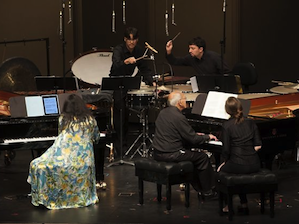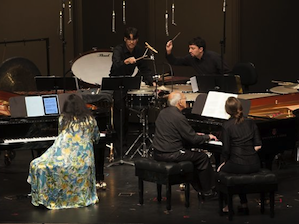
Photo by Tristan Cook
Piano/Piano, the opening concert of this summer’s Music@Menlo chamber music festival, fulfilled its billing with a sustained, century-spanning double-dose of keyboard artistry. But with one exception — Schubert’s four-handed Rondo in A Major, D. 951 — the program at the Center for the Performing Arts at Menlo-Atherton was not one for strict piano purists.
Assorted other instrumentalists joined the paired pianists along the way. Nine string players formed a stately half circle around Derek Han and Gloria Chien for Bach’s Concerto for Two Pianos in C Major, BWV 1061. Cellists David Finckel and Laurence Lesser and French horn player Kevin Rivard complemented those same two pianists in Schumann’s Andante for Two Pianos, Two Cellos, and Horn, Op. 46. After intermission, Christopher Froh and Ian Rosenbaum served as the busily adroit collaborators of pianists Wu Han and Gilbert Kalish in Bartók’s Sonata for Two Pianos and Percussion, BB 115.
All those other participants, it turned out, provided a felicitous backdrop that only made the piano’s expressive range, versatility, and dynamism stand out more distinctly. After an “excruciating 11-month wait,” as co-artistic director Wu Han deemed it in her exuberant season-opening remarks, the 2013 edition of Music@Menlo got off to a delectable, if sometimes ragged, start with a thoroughly pianistic evening.
Even the somewhat odd positioning of the two Steinways, which exposed the keyboards to a full frontal view, with the pianists’ backs to the audience, underscored the point. This was a celebration of the piano times two, a double master to its humble and devoted servants. Never mind that Bach actually wrote for the harpsichord or that the more demure pianos Schubert and Schumann employed weren’t the equivalent of a modern, sonically thundering instrument. Once again, in the proper hands, the piano proved itself fully capable of time travel across a spectrum of fine gradations and firepower.
The participants provided a felicitous backdrop that only made the piano’s expressive range, versatility, and dynamism stand out more distinctly.
The flattering effects of the supporting players were apparent right away, in the Bach concerto. Firmly declarative as the opening bars sounded, in Han and Chien’s assertive and crisp staccato attacks, the amplitude of the wondrous, perpetual-motion first movement came fully into view when the strings echoed and expanded on the opening material. Then when the strings fell silent for the gorgeously unfolding Adagio, another kind of pleasure dawned. Both pianists achieved a striking separation and transparency of their right and left hands, so that it seemed as if there were four pianists, not just two. The feeling was almost orchestral. In the spry and witty Vivace, the pianists’ feathery arpeggios played off against the decisive, fugally developed themes, with the sum effect once more heightened by the strings.
Schumann’s Andante and Variations came off as both intimately conversant and somewhat ungoverned. The piece, which is languorous and yet tightly wrought, starts and ends in murmurous, almost tentative understatement, beautifully carried off here by Han and Chien and their cello and horn accomplices. In between come variations that range from fury to wit, grandeur to blurry skitterings.
Not all of that got a precise or unified reading. Chien spoke more loudly and even intrusively than Han. Finckel overplayed his fellow cellist Lessing’s more-muted hand. Articulation and dynamic command wavered. But there were still plenty of things to savor, none more than the smart, proud parade of the grand variation just before a musing, contemplative close.
It was hard not to have a sneaking suspicion that the hard-working Han and Hyeyeon Park might have had limited rehearsal time for Schubert’s Rondo. They didn’t, at first, seem in full accord on phrasing and tempos. But if the duo was winging it a little, the spontaneous, in-the-moment discovery of chamber music-making came through. The softly rounded contours and flowing gentleness of this performance emerged in charming fashion, with little of the stormy, showy bravado this piece sometimes invokes. A Schubert “Trout” would have been right at home in the music’s modest, limpid stream.
They got to see what we did not: the visible labor and joy of playing two pianos for all they’re worth.
Bartók’s masterly Sonata for Two Pianos and Percussion is a multichambered hall of wonders, rhythmically intense, bittersweet, funny, astringent, and lyrical. With The Rite of Spring fresh in listeners’ centennially tuned ears, the driving first movement of the Bartók sounded especially startling and propulsive. The festive final Allegro brought Stravinsky’s Petrushka to mind.
Han and Kalish played with fervor and conviction, while missing some of the slyness and dark insinuations of the piece. They might have communicated more successfully if the piano alignment had allowed for eye contact. Nothing was amiss, though, with Froh and Rosenbaum, who were wired into every nuance and deliciously jarring detail of the percussion score. Peering directly into the pianists’ faces, they got to see what we did not: the visible labor and joy of playing two pianos for all they’re worth. Hearing it, of course, is the ultimate reward.

